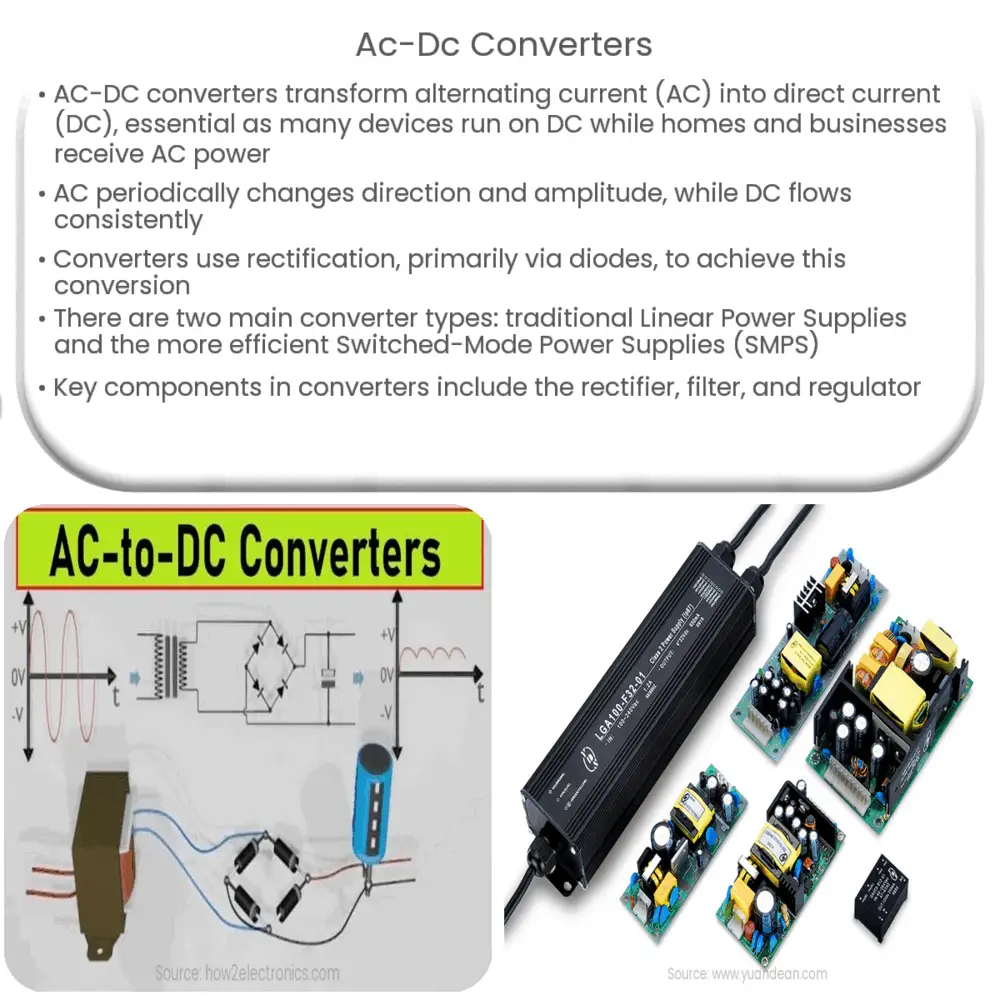Explore the world of AC-DC converters, their working principle, types, and emerging trends in this comprehensive guide.

Introduction to AC-DC Converters
An AC-DC converter, as the name implies, is an electronic device that can convert alternating current (AC) into direct current (DC). This conversion process is essential because many electronic devices operate on DC, despite AC being the primary mode of power supply in most residential and commercial setups.
Understanding AC and DC
Alternating Current (AC) and Direct Current (DC) represent the two primary types of electrical current. AC, which periodically changes its direction and amplitude, is the standard form of electricity supplied to homes and businesses. On the other hand, DC flows consistently in one direction and is commonly used by electronic devices such as smartphones, laptops, and televisions.
The Need for AC-DC Conversion
Since many electronic devices require DC power but are often supplied with AC power, there arises a need for conversion. An AC-DC converter, therefore, acts as an intermediary to convert the power supply into a format that the electronic device can utilize.
The Basic Principle of AC-DC Converters
AC-DC converters use a process known as rectification to convert AC into DC. This process is achieved primarily through electronic components known as diodes, which allow current to flow in one direction but block it in the opposite direction. Rectification can be of two types: half-wave rectification and full-wave rectification, both having different efficiencies and applications.
Types of AC-DC Converters
- Linear Power Supplies: These are traditional converters, characterized by a simple design and low output noise. However, they are less efficient and generate more heat.
- Switched-Mode Power Supplies (SMPS): These are modern converters with a complex design, high efficiency, and less heat generation. They are, however, prone to producing high-frequency noise.
The choice between these converters depends on the specific requirements of the application. While linear power supplies may be suitable for low-noise applications, SMPS is preferred for its efficiency, particularly in power-hungry systems.
Important Components in AC-DC Converters
- Rectifier: The rectifier is a set of diodes that convert the AC waveform into a pulsating DC waveform.
- Filter: After rectification, the DC output is not pure. It contains AC components in the form of ripples. A filter, often a capacitor, is used to smoothen the DC waveform.
- Regulator: The regulator ensures a constant output voltage despite variations in the input voltage or load.
AC-DC converters are critical in today’s electronic landscape, bridging the gap between the standard power supply and the power requirements of countless devices. In the following section, we’ll delve deeper into the working of these converters, their design considerations, and the emerging trends in this field.
Detailed Working of AC-DC Converters
AC-DC converters typically consist of four stages: Transformer, Rectifier, Filter, and Regulator. The Transformer steps down the high-voltage AC supply to a safe, lower voltage level. The Rectifier converts the stepped-down AC into a pulsating DC. The Filter smoothens the pulsating DC, and finally, the Regulator ensures a constant DC output regardless of changes in the input or load.
Design Considerations
Designing an AC-DC converter requires a careful understanding of several parameters like input voltage, output voltage, load current, efficiency, and noise. These parameters are essential as they directly influence the choice of components, circuit topology, and control methods.
Emerging Trends
With technological advancements, AC-DC converters have become more compact, efficient, and reliable. Innovations are primarily driven by a growing demand for power efficiency and the integration of renewable energy systems. Notably, the development of GaN (Gallium Nitride) and SiC (Silicon Carbide) based converters has led to significant improvements in terms of efficiency and power density.
Conclusion
In conclusion, AC-DC converters play a pivotal role in our daily lives, enabling a multitude of electronic devices to function correctly with the standard AC power supply. From simple linear power supplies to more advanced switched-mode power supplies, these converters continue to evolve, adapting to the changing demands of power electronics. Understanding their function and working principle is crucial for any electronics enthusiast or professional. As we progress into the future, the quest for more efficient and compact converters continues, driving innovations and leading to a more sustainable and power-efficient world.

